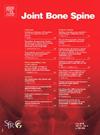Use of corticosteroid therapy in persistent synovitis following septic arthritis in adults: Report of 12 cases
IF 3.8
3区 医学
Q1 RHEUMATOLOGY
引用次数: 0
Abstract
Context
Septic arthritis management relies on appropriate antibiotic therapy and joint drainage. Despite quick microbial eradication, recovery is often incomplete, with significant sequelae such as loss of joint mobility affecting over 30% of patients, sometimes requiring surgery. Persistent synovitis after treatment poses clinical challenges, and the use of corticosteroids as a way to reduce this residual inflammation has been poorly studied.
Method
This retrospective, uncontrolled series evaluated the clinical efficacy of corticosteroid therapy in 12 adult patients with persistent synovitis following native septic arthritis.
Results
Twelve patients were included, most with knee arthritis (10/12, 83.3%). Median antibiotics course before corticosteroids was 14 days (7–30) and all had controlled infections. Route of administration was mostly intra-articular (10/12, 83.3%). Complete (8/12, 66.7%) or partial (3/12, 25.0%) clinical improvement was obtained with a median response time of 2 days. At the end of follow-up, 75% of cases (9/12) met primary endpoint. There were no early infectious complications. Three cases were classified as treatment failures: one patient had no clinical improvement, and two eventually required knee arthroplasty.
Conclusion
Addressing an issue for which there is no data for adult patients, our results suggest that corticosteroids could be an effective option to treat « persistent synovitis » after septic arthritis restoring joint function and preventing long-term disability. This small, retrospective and descriptive study has limitations and larger, randomized studies are needed to confirm these results.
使用皮质类固醇治疗成人化脓性关节炎后持续性滑膜炎。
背景:脓毒性关节炎的治疗依赖于适当的抗生素治疗和关节引流。尽管可以快速清除微生物,但恢复往往是不完整的,有明显的后遗症,如超过30%的患者关节活动能力丧失,有时需要手术。治疗后的持续性滑膜炎带来了临床挑战,使用皮质类固醇作为减少这种残余炎症的方法的研究很少。方法:回顾性,非对照系列评估皮质类固醇治疗的临床疗效的12名成人患者持续性滑膜炎原发化脓性关节炎。结果:纳入12例患者,以膝关节关节炎为主(10/12,83.3%)。使用皮质类固醇前的抗生素疗程中位数为14天(7-30天),所有患者感染均得到控制。给药途径以关节内给药为主(10/12,83.3%)。75%的病例(9/12)达到完全(58.3%,7/12)或部分(16.7%,2/12)临床改善,中位缓解时间为2天。无早期感染并发症。三个病例被归类为治疗失败:一个患者没有临床改善,两个最终需要膝关节置换术。结论:解决了一个没有成人患者数据的问题,我们的研究结果表明,皮质类固醇可能是治疗化脓性关节炎后“持续性滑膜炎”的有效选择,可以恢复关节功能并预防长期残疾。这项小型、回顾性和描述性研究有局限性,需要更大规模的随机研究来证实这些结果。
本文章由计算机程序翻译,如有差异,请以英文原文为准。
求助全文
约1分钟内获得全文
求助全文
来源期刊

Joint Bone Spine
医学-风湿病学
CiteScore
4.50
自引率
11.90%
发文量
184
审稿时长
25 days
期刊介绍:
Bimonthly e-only international journal, Joint Bone Spine publishes in English original research articles and all the latest advances that deal with disorders affecting the joints, bones, and spine and, more generally, the entire field of rheumatology.
All submitted manuscripts to the journal are subjected to rigorous peer review by international experts: under no circumstances does the journal guarantee publication before the editorial board makes its final decision. (Surgical techniques and work focusing specifically on orthopedic surgery are not within the scope of the journal.)Joint Bone Spine is indexed in the main international databases and is accessible worldwide through the ScienceDirect and ClinicalKey platforms.
 求助内容:
求助内容: 应助结果提醒方式:
应助结果提醒方式:


